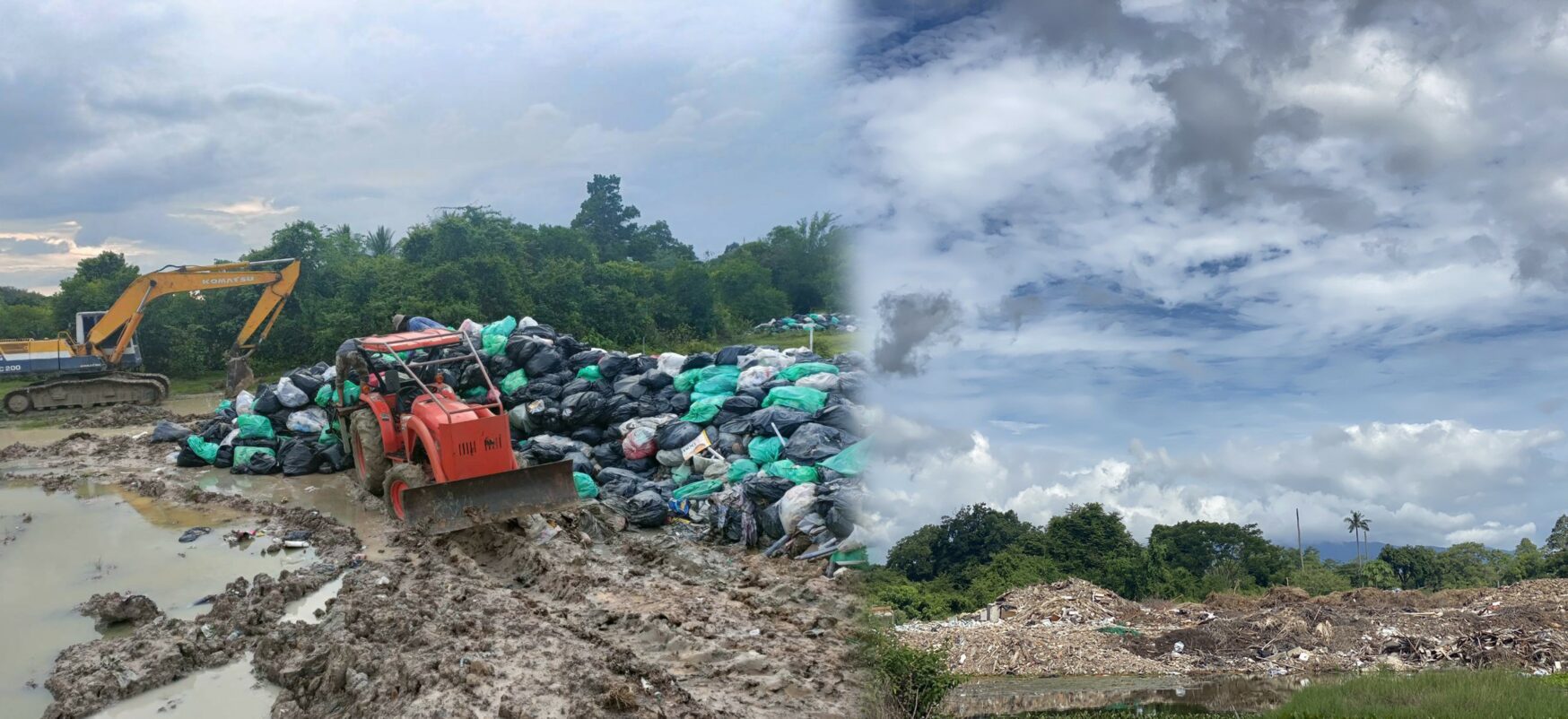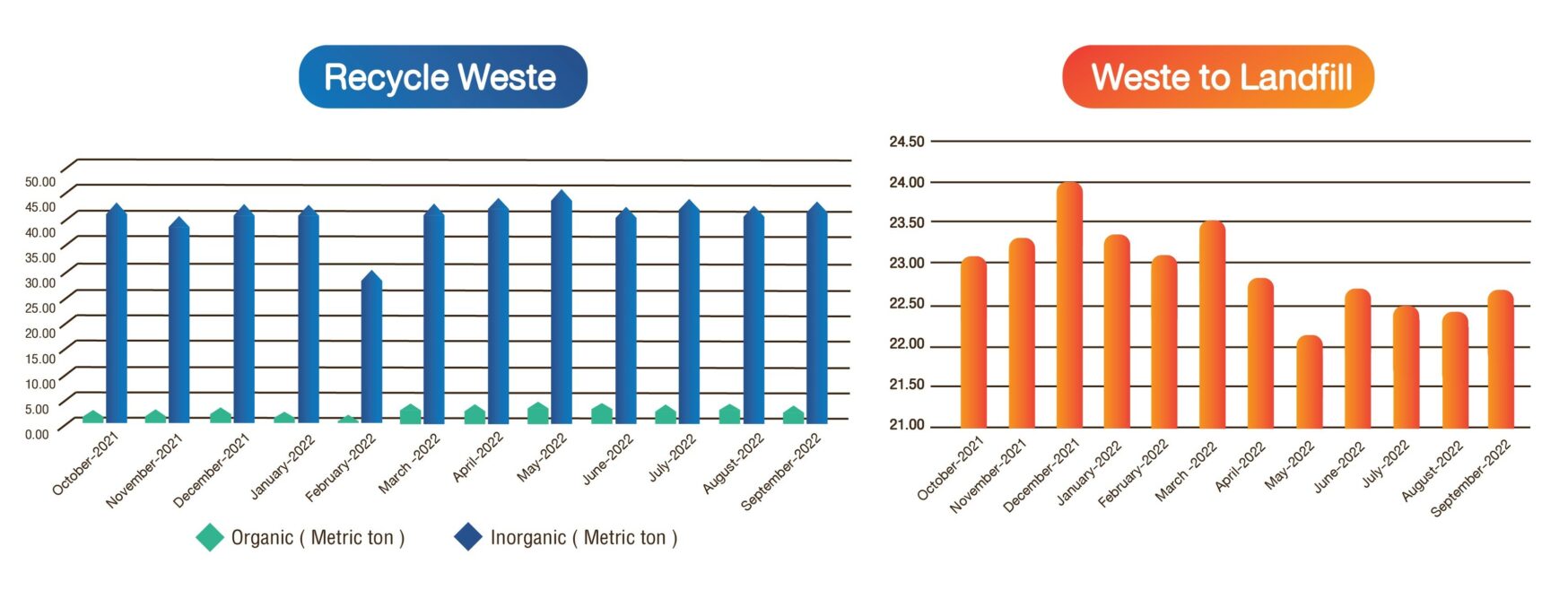The Process of Waste Measurement for the Whole University
Walailak University employs sustainable waste management principle within the framework of the ongoing “Green University Project.” The university aims to make zero waste management, taking into consideration economic, social, and environmental sustainability in line with the Sustainable Development Goals (SDGs). Also, the university has a waste management project, which is responsible for managing all the waste within the university. Besides, the university places great importance on measures the amount of waste generated and recycled across the university, from the source, through the middle stages, to the final disposal of the waste. This is done as follows:
1. The process of monitoring and measuring the amount of waste: Begin
The university monitors and manages the amount of food waste generated at the source within its campus area, including lecture buildings, food centers, markets, student dormitories, staff dormitories, office buildings, sport centers, parks, and Walailak University hospital. The process involves the following steps:
(1.) Creating campaigns and producing video materials for public awareness to foster understanding and stimulate prevention of waste generation. Additionally, informing the public on separating various types of waste and explaining the methods of disposing of each waste type.

(2.) The waste separation, aimed at determining the daily amount of waste generated, is facilitated by creating awareness about the importance of separating different types of waste. The university employs clear type labels and color-coded waste bins, with sample waste items depicted for easy user comprehension. All waste bins of each type are uniformly designed to build knowledge, understanding, and user convenience for proper waste separation. The waste is categorized into four types.
- Green for garbage that decomposes naturally in a short period
- Blue for general waste that is difficult to decompose, re-manufacturing is not cost-effective and non-toxic
- Yellow for waste that can be recycled for reuse, even if it is a material that is difficult to decompose.
- Dark red for hazardous waste that is contaminated with chemicals and dangerous to the body and the environment
- Red for infectious waste generated from medical treatment procedures, medical diagnosis, immunization, and disease experiments which will or may contain germs mixed in
Furthermore, once waste is separated by type, the designated building staff will handle the transfer of waste from bins to the collection points for each waste type. They arrange the waste bins in accordance with the type labels.
2. The process of monitoring and measuring the amount of waste: Midway
When each type of waste is collected and placed at the designated points, waste collection vehicles operate to collect waste from each location within the university. Waste collection occurs throughout the university four times a day, with two rounds in the morning and two rounds in the afternoon. There are different collection routes for each round, as follows:

Morning Rounds:
Morning Round 1: Student Dormitories and Administrative Buildings
Morning Round 2: The Center for Scientific and Technology Equipment Buildings, Academic Buildings, Walailak University Hospital, Large Animal Hospital Building, Walailak Park (inner line)

Afternoon Rounds:
Afternoon Round 1: Staff Housing, Sport Field, Botanic Park, and Smart Farm (outer line)
Afternoon Round 2: Food Centers

3. The process of monitoring and measuring the amount of waste: End
The waste collected from each waste collection point across the entire university is brought together, and the university carries out the following processes: tracking the quantity of waste, recording the weight of the waste, and segregating the waste at the waste management facility, which is part of Walailak University’s waste management project. Due to the different management and disposal methods for each type of waste, proper and appropriate segregation and disposal according to environmental health principles are essential to prevent environmental issues. Walailak University has, therefore, classified waste into two categories:
1. Recycled WasteSorting
Walailak University has a recycling waste process to turn the waste into something that can be used again. The waste might be the same or transformed into another item for other functions. Most of the recycled waste at WU is inorganic waste. The inorganic waste that cannot be recycled at WU will be sold to the industrial plants of private companies. In addition, WU recycles the organic waste produced by all foot outlets at WU as animal feed and compost.
2. Non-recyclable Waste Sorting
Non-recyclable waste, including metal, rubber, fabric, or organic waste with long-term biodegradability, will be sent to landfills.

In addition, the university has conducted a study of waste management in community households, local administrative organizations, and hotel businesses in the upper southern region to develop appropriate waste management practices for the context of community households, local administrative organizations, and hotel businesses. Policy recommendations have been made for solid waste management system according to the context of each source. As a result, this approach has led to a reduction in the volume of waste generated at the source of each target group, a decrease in the amount of waste sent to final disposal sites, and an increase in the quantity of waste being utilized for beneficial purposes. Currently, the project to develop the wastewater treatment system, hazardous waste, and general waste management system serves as a model for learning about wastewater treatment and waste management. It has garnered significant interest from both public and private sector organizations.
From the waste tracking data across the whole university for 2021 and 2022, it’s evident that there are variations in the quantities of different types of waste. In 2022, the total annual waste quantity was 812.28 tons, which averages to approximately 2.26 tons per day. There are two main types, including:


1. The Recyclable Waste or Waste That Can Be Reused
The recyclable waste or waste that can be reused, amounting to 536.635 metric tons per year, or approximately 1.49 metric tons per day, accounting for 66.06% of the total waste. This category includes inorganic waste that can be reintroduced and organic waste that can be decomposed into compost or used as animal feed. Certainly, here’s a breakdown of the details:
2.1 the inorganic waste that can be recycled or reused amounts to 194.851 metric tons per year: This type of waste can be recycled or processed to become new materials that can be reused. It may either retain its original form or be transformed into new materials that are suitable for reuse. The university sells this waste to industrial plants for recycling, including Refuse Derived Fuel (RDF). This is solid waste that has gone through various management processes, such as separating combustible materials from incinerators, tearing or cutting garbage into small pieces in order to improve and convert waste into solid fuel that has properties in terms of heating value. The remaining ash and residue from the incineration process are utilized by the university for mixing concrete. When calculating the proportion of recycled waste in 2022, it accounts for approximately 23.99% of the total waste generated.


2.2 the organic waste that can be decomposed and converted into compost or animal feed: These recyclable waste materials, used as animal feed and compost, include food scraps, plant leaves, and wood branches. In 2022, the total quantity of this waste type was 341.784 tons, accounting for approximately 42.08% of the total waste generated. Indeed, this type of waste is organic waste that is decomposed and can be reused and is beneficial to living things, plants, and animals. The university uses these organic waste materials to feed pigs and produce compost for fruit-bearing plants, ornamental trees within university. Additionally, the remaining materials are sold to generate revenue for the university.
- 2. Landfill Waste
The landfill waste, such as metal scraps, rubber, cloth remnants, and other, which cannot be reused, is disposed of through landfill. There’s an annual quantity of 275.645 metric tons, equivalent to 0.77 metric tons per day, accounting for 33.94% of the total waste. It is the general waste that decomposes over a long period, such as large wood scraps and durian peels, accounts for 200.345 metric tons per year (24.67%). Sharp waste such as tile scraps, glass scraps 9.754 tons per year (1.20 percent) and others such as scrap rubber and leather scraps 65.546 tons per year (8.07 percent).


When comparing the waste tracking data for the year 2021 to the year 2022, it was found that there was an increase in the amount of recyclable waste in 2022 compared to the previous year. In 2021, there was a total of 390.895 metric tons per year or 1.09 metric tons per day of recyclable waste, which includes both organic and inorganic waste that can be reused. This accounted for 50.77% of the total waste generated in that year.
In 2022, there was a total of 536.635 metric tons per year or 1.49 metric ton per day of recyclable , which includes both organic and inorganic waste that can be reused. This accounted for 66.07% of the total waste generated in that year.
Even though the increase in the population in 2022 led to a slight rise in the proportion of recyclable waste compared to 2024 (accounted to 0.8%), it’s essential to note that the university has been continuing to actively follow its waste reduction policy and employs comprehensive waste management principles under the Green University initiative. The efforts to raise awareness and promote waste reduction among students and staff, as well as the decrease in the amount of waste sent to landfills, resulted in a 1.14% reduction, contributing to a 0.46% decrease in the overall waste volume from the year 2021. Currently, the university’s goal is zero waste management by promoting waste separation and proper waste management to reduce environmental pollution. Additionally, these practices help conserve energy and resources.
Related link:
Goal 12: Responsible consumption and production

